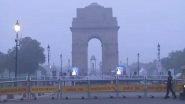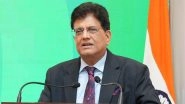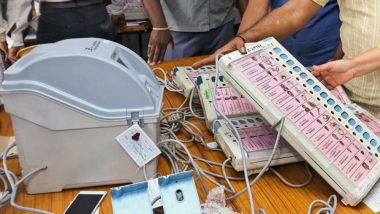Voting for the second phase of Lok Sabha Elections 2019 in India began on Thursday, April 18. The first phase of elections was held on April 11. The stage is all set for polling across 95 Lok Sabha constituencies spread over 12 states and Union Territories as the second phase of the seven-phase electoral exercise kicked off on Thursday. It becomes important for people to know how they should cast their votes during the upcoming polls. In order to cast the vote, people in India must have a Voter’s ID or the Electors Photo Identity Card (EPIC) issued by the Election Commission of India (ECI). The voter ID is a mandatory document during the verification process before casting a vote. How to Check Your Name In Voter List?
Search giant Google today marked the beginning of General Elections in India with a doodle that shows the inked finger. Clicking on the inked finger leads users to a page that explains and answers 'how to vote in #India'. The page also contains information which can be of great helpful for first-time voters in the country.
As the seven-phased general election is slated to begin on April 11, thousands of the nation's youth wait to cast their votes in favour of their preferred candidate. Eligible voters in India must be over the age of 18 to cast a 38vote. What Are Electoral Reforms? Know History of Polls in India Ahead of Lok Sabha Elections 2019.
Lok Sabha Elections 2019 | How To Vote in #India? Use of EVM And Verify on VVPAT (Watch Video):
Here's How to Cast Your Vote
- Once you enter the polling booth room, show your voter ID or other ID to the polling officer to tally your name in the voter's list. Then, the polling official will check your name in the voter list, will take a look at your ID card and ink your finger and will send you to the EVM to cast your vote.
- Then, the polling official will ink your finger, give you a slip and take your signature on a register (Form 17A). You will then have to deposit the slip at the third polling official and show your inked finger and then proceed to the polling booth.
- The polling machine operates on the "press a button" mode and there are no papers involved. An EVM typically comprises a ‘Control Unit’ and a ‘Ballot Unit’ which are connected by a 5-metre wire.
- Beside every candidate’s name and party symbol on the machine, there’s a blue button. The voter needs to press the button adjacent to the name of the candidate of their choice and the respective party’s symbol. The machine then records the vote.
- The Control Unit is placed with the Presiding Officer or a Polling Officer and the Balloting Unit is placed inside the voting compartment.
- Instead of issuing a ballot paper, the Polling Officer in-charge of the Control Unit will release a ballot by pressing the Ballot Button on the Control Unit.
- This will enable the voter to cast his vote by pressing the blue button on the Balloting Unit against the candidate and symbol of his choice.
After the voter has pressed one button on the machine, it gets locked for any further vote. Therefore, voters are advised to think hard before casting their vote. If the voter presses after the first attempt, it will not be counted as a vote. What Is EVM? FAQs Answered on Electronic Voting Machine Ahead of Lok Sabha Elections 2019.
How does the VVPAT work
- The Voter Verifiable Paper Audit Trail (VVPAT) is an independent system attached with the EVM that allows the voters to verify that their votes are cast as intended.
- When a vote is cast, a slip is printed containing the serial number, name and symbol of the candidate and remains exposed through a transparent window for 7 seconds.
- Thereafter, this printed slip automatically gets cut and falls in the sealed drop box of the VVPAT.
How Can a Voter be Sure That Vote Has Been Recorded
- As soon as the voter presses the `blue button' against the candidate and symbol of his choice, the lamp against symbol of that particular candidate glows red and a long beep sound is heard.
- Thus, there is both audio and visual indications for the voter to be assured that his vote has been recorded correctly.
- In addition, VVPAT provides an additional visual verification in the form of paper slip to the voter so he can ensure that his vote has been correctly recorded for the candidate of his choice.
Who Can Cast a Vote
- Any Indian citizen who has attained the age of 18 years on the first day of January of the year, is eligible to cast your vote in this 17th Lok Sabha election.
- Reports inform that approximately 900 million voters will be participating in the upcoming elections of which 15 million fall in the age bracket of 18-19 years.
- The most important key criteria for an individual is that he/she must be a resident of the polling area of the constituency where he/she wants to be enrolled.
- The citizen will still be able to exercise their voting rights if they carry alternative documents - issued by the union government, state government, public limited companies - to the polling booths for establishing their identity.
How to Register as a Voter
If an individual wants to register as a voter, he/she can file an application, in prescribed Form-6 with a passport size photo before the Electoral Registration Officer/Assistant Electoral Registration Officer of their constituency. Lok Sabha Elections 2019 Schedule: Voting In 7 Phases From April 11 to May 19, Counting And Results On May 23; Check All Dates For General Elections.
As part of the offline process, the individual will have to fill the application along with the copies of the relevant documents and send to the Booth Level Officer of the polling area by post. Individuals can also file the application online at the National Voters’ Service Portal — www.nvsp.in.
Voters are required to carry two sets of documents – ID proof and address proof. If the individual has a passport and a driving license, it will serve both purposes. For ID proof, a PAN card and student identification can work while bank passbook, ration card, post office passbook, water / electricity / gas connection bill can work as address proof.
Stage is all set for polling in 91 Lok Sabha constituencies across 20 states and Union Territories on Thursday in the first of seven-phased polls to elect a new government at the Centre.
(The above story first appeared on LatestLY on Apr 18, 2019 08:43 AM IST. For more news and updates on politics, world, sports, entertainment and lifestyle, log on to our website latestly.com).













 Quickly
Quickly











